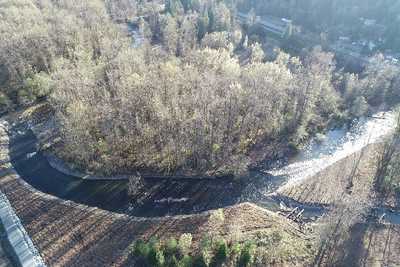Rutledge Johnson Geomorphic Assessment
The Rutledge Johnson levee and revetment disconnects a 17 acre floodplain of the
Cedar River. To restore in-channel and floodplain habitat by enabling fluvial processes to again reshape the floodplain, King County proposes to remove a portion of the Rutledge Johnson facility, reconnect a relict floodplain channel, and add sufficient in-stream wood to provide high-quality and sustainable salmonid habitat.
WSE was retained to provide geomorphic and hydraulic modeling support for project design by evaluating existing geomorphic conditions, assessing how the site may evolve over the next 50 years, and assessing how the project may alter that evolutionary trajectory. Key objectives included determining how the project might alter geomorphic risk to infrastructure and private property and whether the project could create geomorphically sustainable habitat. A key objective for both managing risk and
sustainably restoring salmonid habitat was to create a side channel that did not immediately cut off (i.e., experience avulsion through) the large meander bend created by this floodplain. WSE conducted a detailed study of how wood and channel planform affect avulsion risk on the Cedar River, and is bringing those insights to help guide design for this project. WSE is also performing geomorphic scenario analysis using a 2D HEC-RAS hydraulic model of the reach by simulating potential geomorphic evolution scenarios and using the model to predict how geomorphic evolution may affect patterns of sediment transport capacity, erosion and deposition, wood mobility, and geomorphic risk.
WSE Role/Services:
- Evaluating the sediment and wood regime of the Cedar River
- Using insights from geomorphic investigations to provide actionable design suggestions
- Evaluating geomorphic risk related to channel migration and wood
- Conducting geomorphic scenario modeling to evaluate hydraulic impacts of anticipated geomorphic evolution
- Recommending both general design considerations and specific design refinements to maximize sustainability and minimize geomorphic risk
Outcome:
The project is ongoing. WSE has produced an existing conditions geomorphic assessment and is currently finalizing an anticipated conditions geomorphic assessment to guide final design.
